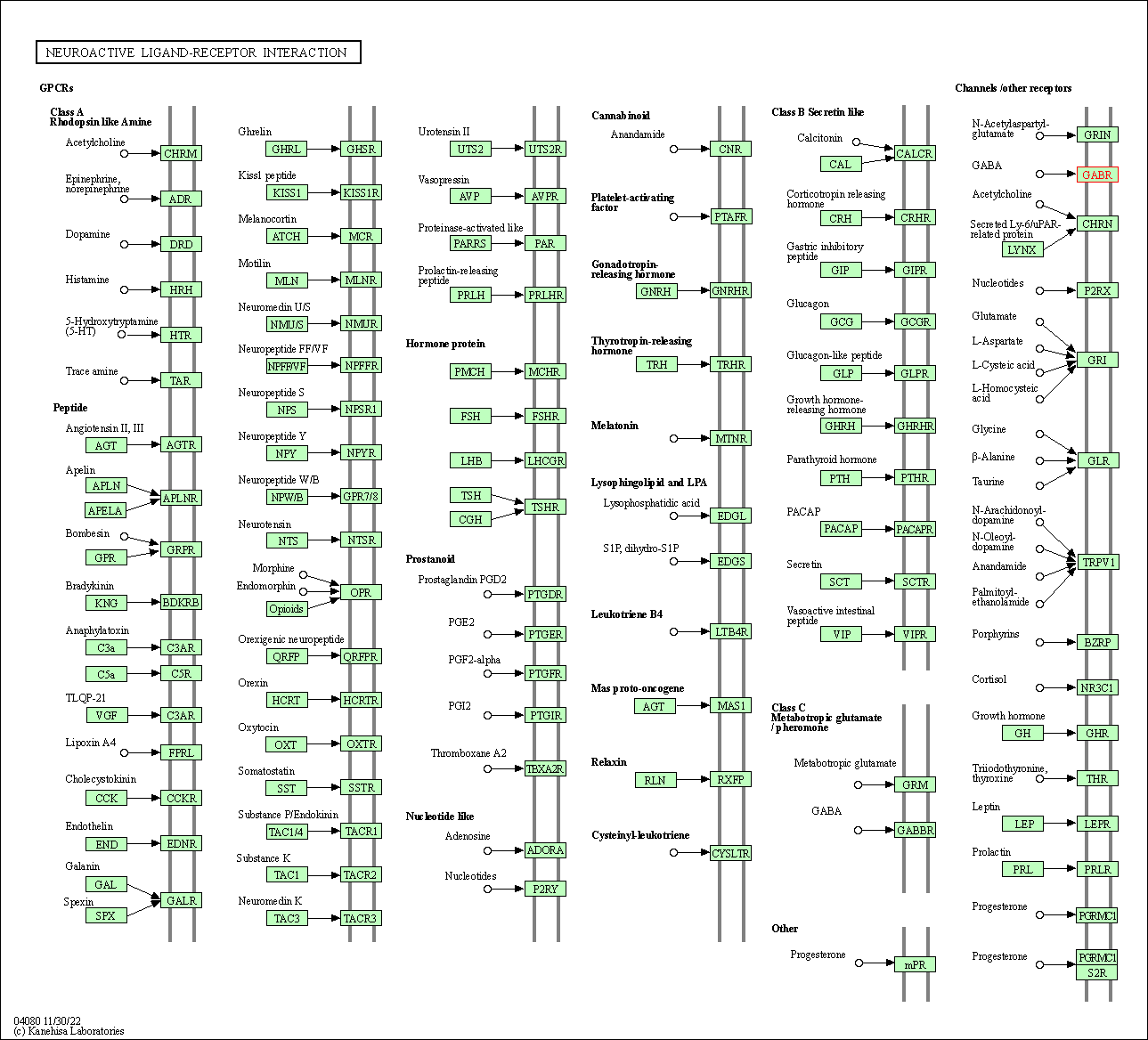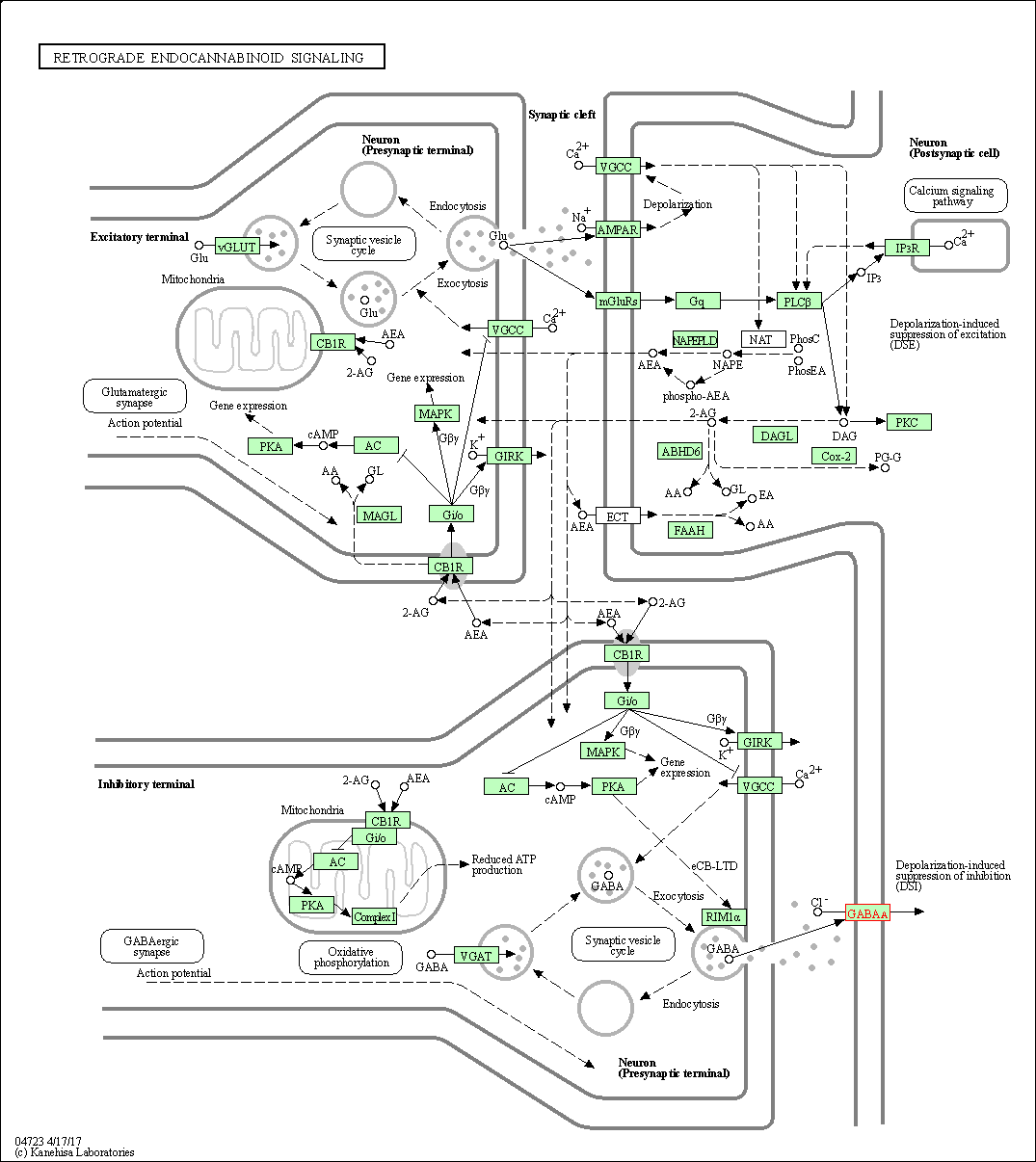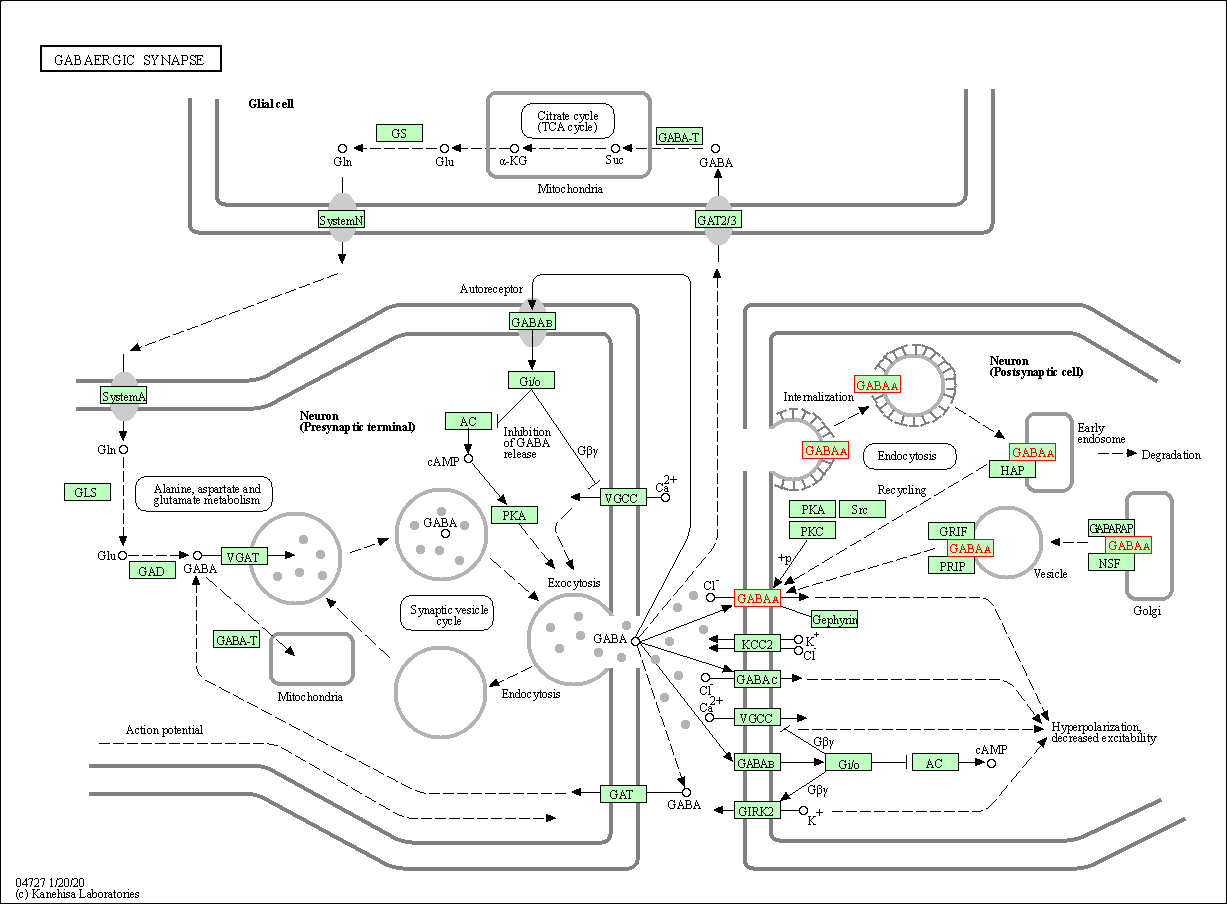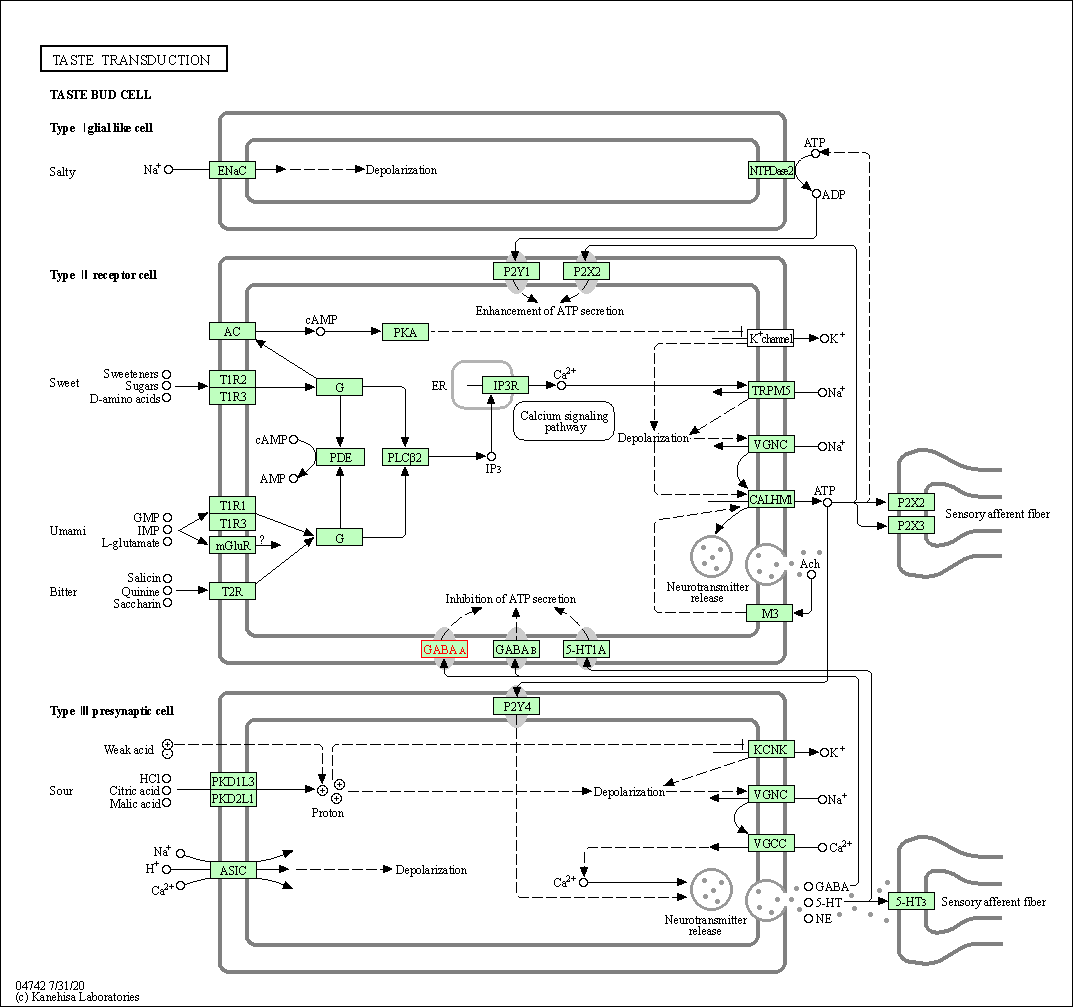Target Information
| Target General Information | Top | |||||
|---|---|---|---|---|---|---|
| Target ID |
T62292
(Former ID: TTDR01178)
|
|||||
| Target Name |
GABA(A) receptor alpha-3 (GABRA3)
|
|||||
| Synonyms |
Gamma-aminobutyric acid receptor subunit alpha-3; GABA-A receptor alpha 3; GABA(A)Gamma-aminobutyric-acid receptor alpha-3 subunit precursor receptor; GABA(A) receptor subunit alpha-3
Click to Show/Hide
|
|||||
| Gene Name |
GABRA3
|
|||||
| Target Type |
Successful target
|
[1] | ||||
| Disease | [+] 1 Target-related Diseases | + | ||||
| 1 | Intentional self-harm [ICD-11: PC91] | |||||
| Function |
GABA, the major inhibitory neurotransmitter in the vertebrate brain, mediates neuronal inhibition by binding to the GABA/benzodiazepine receptor and opening an integral chloride channel.
Click to Show/Hide
|
|||||
| BioChemical Class |
Neurotransmitter receptor
|
|||||
| UniProt ID | ||||||
| Sequence |
MIITQTSHCYMTSLGILFLINILPGTTGQGESRRQEPGDFVKQDIGGLSPKHAPDIPDDS
TDNITIFTRILDRLLDGYDNRLRPGLGDAVTEVKTDIYVTSFGPVSDTDMEYTIDVFFRQ TWHDERLKFDGPMKILPLNNLLASKIWTPDTFFHNGKKSVAHNMTTPNKLLRLVDNGTLL YTMRLTIHAECPMHLEDFPMDVHACPLKFGSYAYTTAEVVYSWTLGKNKSVEVAQDGSRL NQYDLLGHVVGTEIIRSSTGEYVVMTTHFHLKRKIGYFVIQTYLPCIMTVILSQVSFWLN RESVPARTVFGVTTVLTMTTLSISARNSLPKVAYATAMDWFIAVCYAFVFSALIEFATVN YFTKRSWAWEGKKVPEALEMKKKTPAAPAKKTSTTFNIVGTTYPINLAKDTEFSTISKGA APSASSTPTIIASPKATYVQDSPTETKTYNSVSKVDKISRIIFPVLFAIFNLVYWATYVN RESAIKGMIRKQ Click to Show/Hide
|
|||||
| 3D Structure | Click to Show 3D Structure of This Target | AlphaFold | ||||
| HIT2.0 ID | T56MO9 | |||||
| Drugs and Modes of Action | Top | |||||
|---|---|---|---|---|---|---|
| Approved Drug(s) | [+] 1 Approved Drugs | + | ||||
| 1 | Flumazenil | Drug Info | Approved | Benzodiazepine overdose | [2], [3] | |
| Clinical Trial Drug(s) | [+] 3 Clinical Trial Drugs | + | ||||
| 1 | Adipiplon | Drug Info | Phase 2 | Sleep-wake disorder | [4] | |
| 2 | GSK683699 | Drug Info | Phase 2 | Inflammatory bowel disease | [5] | |
| 3 | NS-2710 | Drug Info | Phase 2 | Anxiety disorder | [6] | |
| Discontinued Drug(s) | [+] 1 Discontinued Drugs | + | ||||
| 1 | AZD6280 | Drug Info | Discontinued in Phase 1 | Schizophrenia | [7] | |
| Mode of Action | [+] 5 Modes of Action | + | ||||
| Modulator (allosteric modulator) | [+] 8 Modulator (allosteric modulator) drugs | + | ||||
| 1 | Flumazenil | Drug Info | [1] | |||
| 2 | alpha3IA | Drug Info | [1] | |||
| 3 | alpha5IA | Drug Info | [1] | |||
| 4 | DMCM | Drug Info | [1] | |||
| 5 | tetrahydrodeoxycorticosterone | Drug Info | [1] | |||
| 6 | TP003 | Drug Info | [1] | |||
| 7 | [18F]fluoroethylflumazenil | Drug Info | [1] | |||
| 8 | [3H]CGS8216 | Drug Info | [1] | |||
| Modulator | [+] 5 Modulator drugs | + | ||||
| 1 | Adipiplon | Drug Info | [8] | |||
| 2 | NS-2710 | Drug Info | [6] | |||
| 3 | AZD6280 | Drug Info | [10] | |||
| 4 | MK-0343 | Drug Info | [17] | |||
| 5 | MRK016 | Drug Info | [18] | |||
| Inhibitor | [+] 28 Inhibitor drugs | + | ||||
| 1 | GSK683699 | Drug Info | [9] | |||
| 2 | (2E,4S)-4-ammoniopent-2-enoate | Drug Info | [11] | |||
| 3 | (4R)-4-ammoniopentanoate | Drug Info | [11] | |||
| 4 | (4S)-4-ammoniopentanoate | Drug Info | [11] | |||
| 5 | 3-(3-Methyl-butoxy)-9H-beta-carboline | Drug Info | [12] | |||
| 6 | 3-(benzyloxy)-9H-pyrido[3,4-b]indole | Drug Info | [12] | |||
| 7 | 3-(hexa-1,3-dienyloxy)-9H-pyrido[3,4-b]indole | Drug Info | [12] | |||
| 8 | 3-Butoxy-9H-beta-carboline | Drug Info | [12] | |||
| 9 | 3-Ethoxy-9H-beta-carboline | Drug Info | [12] | |||
| 10 | 3-Isobutoxy-9H-beta-carboline | Drug Info | [12] | |||
| 11 | 3-Propoxy-9H-beta-carboline | Drug Info | [12] | |||
| 12 | 5-[(1R)-1-ammonioethyl]isoxazol-3-olate | Drug Info | [11] | |||
| 13 | 5-[(1S)-1-ammonioethyl]isoxazol-3-olate | Drug Info | [11] | |||
| 14 | 6-benzyl-3-ethoxycarbonyl-4-quinolone | Drug Info | [13] | |||
| 15 | 6-bromo-3-ethoxycarbonyl-4-quinolone | Drug Info | [13] | |||
| 16 | 6-ethyl-3-(3-methylbutoxycarbonyl)-4-quinolone | Drug Info | [13] | |||
| 17 | 9H-beta-Carboline-3-carboxylic acid ethyl ester | Drug Info | [12] | |||
| 18 | AMENTOFLAVONE | Drug Info | [14] | |||
| 19 | Barbituric acid derivative | Drug Info | [15] | |||
| 20 | Beta-Carboline-3-carboxylic acid t-butyl ester | Drug Info | [12] | |||
| 21 | CI-218872 | Drug Info | [12] | |||
| 22 | Ethyl 6-iodo-9H-pyrido[3,4-b]indole-3-carboxylate | Drug Info | [12] | |||
| 23 | L-655708 | Drug Info | [16] | |||
| 24 | Ro-15-3505 | Drug Info | [19] | |||
| 25 | Ro-4938581 | Drug Info | [20] | |||
| 26 | RY-066 | Drug Info | [21] | |||
| 27 | Sec-butyl 9H-pyrido[3,4-b]indole-3-carboxylate | Drug Info | [12] | |||
| 28 | [3H]Ro154513 | Drug Info | [22] | |||
| Agonist | [+] 2 Agonist drugs | + | ||||
| 1 | isonipecotic acid | Drug Info | [1] | |||
| 2 | piperidine-4-sulphonic acid | Drug Info | [1] | |||
| Blocker (channel blocker) | [+] 2 Blocker (channel blocker) drugs | + | ||||
| 1 | TBPS | Drug Info | [1] | |||
| 2 | [35S]TBPS | Drug Info | [1] | |||
| Cell-based Target Expression Variations | Top | |||||
|---|---|---|---|---|---|---|
| Cell-based Target Expression Variations | ||||||
| Different Human System Profiles of Target | Top |
|---|---|
|
Human Similarity Proteins
of target is determined by comparing the sequence similarity of all human proteins with the target based on BLAST. The similarity proteins for a target are defined as the proteins with E-value < 0.005 and outside the protein families of the target.
A target that has fewer human similarity proteins outside its family is commonly regarded to possess a greater capacity to avoid undesired interactions and thus increase the possibility of finding successful drugs
(Brief Bioinform, 21: 649-662, 2020).
Human Tissue Distribution
of target is determined from a proteomics study that quantified more than 12,000 genes across 32 normal human tissues. Tissue Specificity (TS) score was used to define the enrichment of target across tissues.
The distribution of targets among different tissues or organs need to be taken into consideration when assessing the target druggability, as it is generally accepted that the wider the target distribution, the greater the concern over potential adverse effects
(Nat Rev Drug Discov, 20: 64-81, 2021).
Human Pathway Affiliation
of target is determined by the life-essential pathways provided on KEGG database. The target-affiliated pathways were defined based on the following two criteria (a) the pathways of the studied target should be life-essential for both healthy individuals and patients, and (b) the studied target should occupy an upstream position in the pathways and therefore had the ability to regulate biological function.
Targets involved in a fewer pathways have greater likelihood to be successfully developed, while those associated with more human pathways increase the chance of undesirable interferences with other human processes
(Pharmacol Rev, 58: 259-279, 2006).
Human Similarity Proteins
Human Tissue Distribution
Human Pathway Affiliation
|
|
|
There is no similarity protein (E value < 0.005) for this target
|
|
Note:
If a protein has TS (tissue specficity) scores at least in one tissue >= 2.5, this protein is called tissue-enriched (including tissue-enriched-but-not-specific and tissue-specific). In the plots, the vertical lines are at thresholds 2.5 and 4.
|




| KEGG Pathway | Pathway ID | Affiliated Target | Pathway Map |
|---|---|---|---|
| Neuroactive ligand-receptor interaction | hsa04080 | Affiliated Target |

|
| Class: Environmental Information Processing => Signaling molecules and interaction | Pathway Hierarchy | ||
| Retrograde endocannabinoid signaling | hsa04723 | Affiliated Target |

|
| Class: Organismal Systems => Nervous system | Pathway Hierarchy | ||
| GABAergic synapse | hsa04727 | Affiliated Target |

|
| Class: Organismal Systems => Nervous system | Pathway Hierarchy | ||
| Taste transduction | hsa04742 | Affiliated Target |

|
| Class: Organismal Systems => Sensory system | Pathway Hierarchy | ||
| Chemical Structure based Activity Landscape of Target | Top |
|---|---|
| Drug Property Profile of Target | Top | |
|---|---|---|
| (1) Molecular Weight (mw) based Drug Clustering | (2) Octanol/Water Partition Coefficient (xlogp) based Drug Clustering | |
|
|
||
| (3) Hydrogen Bond Donor Count (hbonddonor) based Drug Clustering | (4) Hydrogen Bond Acceptor Count (hbondacc) based Drug Clustering | |
|
|
||
| (5) Rotatable Bond Count (rotbonds) based Drug Clustering | (6) Topological Polar Surface Area (polararea) based Drug Clustering | |
|
|
||
| "RO5" indicates the cutoff set by lipinski's rule of five; "D123AB" colored in GREEN denotes the no violation of any cutoff in lipinski's rule of five; "D123AB" colored in PURPLE refers to the violation of only one cutoff in lipinski's rule of five; "D123AB" colored in BLACK represents the violation of more than one cutoffs in lipinski's rule of five | ||
| Co-Targets | Top | |||||
|---|---|---|---|---|---|---|
| Co-Targets | ||||||
| Target Regulators | Top | |||||
|---|---|---|---|---|---|---|
| Target-regulating microRNAs | ||||||
| Target Profiles in Patients | Top | |||||
|---|---|---|---|---|---|---|
| Target Expression Profile (TEP) |
||||||
| Target Affiliated Biological Pathways | Top | |||||
|---|---|---|---|---|---|---|
| KEGG Pathway | [+] 5 KEGG Pathways | + | ||||
| 1 | Neuroactive ligand-receptor interaction | |||||
| 2 | Retrograde endocannabinoid signaling | |||||
| 3 | GABAergic synapse | |||||
| 4 | Morphine addiction | |||||
| 5 | Nicotine addiction | |||||
| Reactome | [+] 2 Reactome Pathways | + | ||||
| 1 | Ligand-gated ion channel transport | |||||
| 2 | GABA A receptor activation | |||||
| WikiPathways | [+] 2 WikiPathways | + | ||||
| 1 | Neurotransmitter Receptor Binding And Downstream Transmission In The Postsynaptic Cell | |||||
| 2 | Iron uptake and transport | |||||
| Target-Related Models and Studies | Top | |||||
|---|---|---|---|---|---|---|
| Target Validation | ||||||
| Target QSAR Model | ||||||
| References | Top | |||||
|---|---|---|---|---|---|---|
| REF 1 | URL: http://www.guidetopharmacology.org Nucleic Acids Res. 2015 Oct 12. pii: gkv1037. The IUPHAR/BPS Guide to PHARMACOLOGY in 2016: towards curated quantitative interactions between 1300 protein targets and 6000 ligands. (Target id: 406). | |||||
| REF 2 | URL: http://www.guidetopharmacology.org Nucleic Acids Res. 2015 Oct 12. pii: gkv1037. The IUPHAR/BPS Guide to PHARMACOLOGY in 2016: towards curated quantitative interactions between 1300 protein targets and 6000 ligands. (Ligand id: 4192). | |||||
| REF 3 | ClinicalTrials.gov (NCT00997087) A Randomized, Double-Blind, Placebo-Controlled Trial of Flumazenil for the Treatment of Obsessive Compulsive Disorder. U.S. National Institutes of Health. | |||||
| REF 4 | ClinicalTrials.gov (NCT00683436) Efficacy and Safety Study of Adipiplon, Placebo and an Active Control in Primary Insomniacs. U.S. National Institutes of Health. | |||||
| REF 5 | Emerging drugs to treat Crohn's disease. Expert Opin Emerg Drugs. 2007 Mar;12(1):49-59. | |||||
| REF 6 | GABAA receptor subtype-selective modulators. I. alpha2/alpha3-selective agonists as non-sedating anxiolytics. Curr Top Med Chem. 2011;11(9):1176-202. | |||||
| REF 7 | Trusted, scientifically sound profiles of drug programs, clinical trials, safety reports, and company deals, written by scientists. Springer. 2015. Adis Insight (drug id 800027607) | |||||
| REF 8 | Discriminative stimulus properties of GABAA receptor positive allosteric modulators TPA023, ocinaplon and NG2-73 in rats trained to discriminate chlordiazepoxide or zolpidem. Eur J Pharmacol. 2011 Oct 1;668(1-2):190-3. | |||||
| REF 9 | New anticonvulsants: Schiff bases of gamma-aminobutyric acid and gamma-aminobutyramide. J Med Chem. 1980 Jun;23(6):702-4. | |||||
| REF 10 | AZD6280, a novel partial -aminobutyric acid A receptor modulator, demonstrates a pharmacodynamically selective effect profile in healthy male volunteers.J Clin Psychopharmacol.2015 Feb;35(1):22-33. | |||||
| REF 11 | gamma-Aminobutyric acid agonists, antagonists, and uptake inhibitors. Design and therapeutic aspects. J Med Chem. 1981 Dec;24(12):1377-83. | |||||
| REF 12 | Design, synthesis, and subtype selectivity of 3,6-disubstituted -carbolines at Bz/GABA(A)ergic receptors. SAR and studies directed toward agents f... Bioorg Med Chem. 2010 Nov 1;18(21):7548-64. | |||||
| REF 13 | 4-quinolone derivatives: high-affinity ligands at the benzodiazepine site of brain GABA A receptors. synthesis, pharmacology, and pharmacophore mod... J Med Chem. 2006 Apr 20;49(8):2526-33. | |||||
| REF 14 | Semisynthetic preparation of amentoflavone: A negative modulator at GABA(A) receptors. Bioorg Med Chem Lett. 2003 Jul 21;13(14):2281-4. | |||||
| REF 15 | Whiting PJ: The GABAA receptor gene family: new opportunities for drug development. Curr Opin Drug Discov Devel. 2003 Sep;6(5):648-57. | |||||
| REF 16 | 3-phenyl-6-(2-pyridyl)methyloxy-1,2,4-triazolo[3,4-a]phthalazines and analogues: high-affinity gamma-aminobutyric acid-A benzodiazepine receptor li... J Med Chem. 2004 Mar 25;47(7):1807-22. | |||||
| REF 17 | Pharmacodynamic and pharmacokinetic effects of MK-0343, a GABA(A) alpha2,3 subtype selective agonist, compared to lorazepam and placebo in healthy male volunteers.J Psychopharmacol.2008 Jan;22(1):24-32. | |||||
| REF 18 | A randomized clinical trial of MK-0777 for the treatment of cognitive impairments in people with schizophrenia.Biol Psychiatry.2011 Mar 1;69(5):442-9. | |||||
| REF 19 | The GABA(A) receptor as a target for photochromic molecules. Bioorg Med Chem. 2010 Nov 15;18(22):7731-8. | |||||
| REF 20 | The discovery and unique pharmacological profile of RO4938581 and RO4882224 as potent and selective GABAA alpha5 inverse agonists for the treatment... Bioorg Med Chem Lett. 2009 Oct 15;19(20):5940-4. | |||||
| REF 21 | Predictive models for GABAA/benzodiazepine receptor subtypes: studies of quantitative structure-activity relationships for imidazobenzodiazepines a... J Med Chem. 1998 Oct 8;41(21):4130-42. | |||||
| REF 22 | Synthesis and pharmacological properties of novel 8-substituted imidazobenzodiazepines: high-affinity, selective probes for alpha 5-containing GABA... J Med Chem. 1996 Apr 26;39(9):1928-34. | |||||
If You Find Any Error in Data or Bug in Web Service, Please Kindly Report It to Dr. Zhou and Dr. Zhang.

